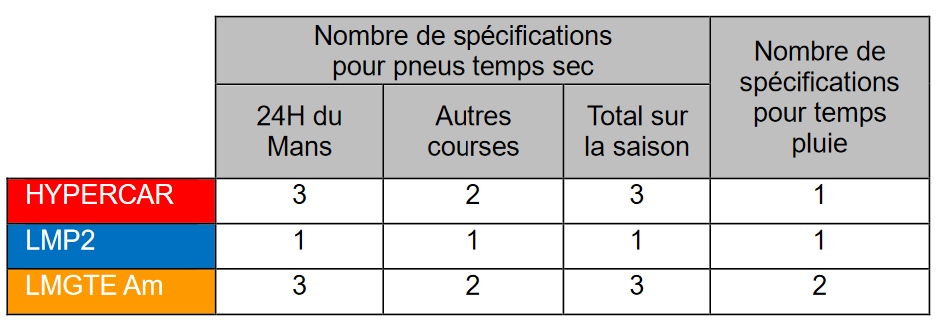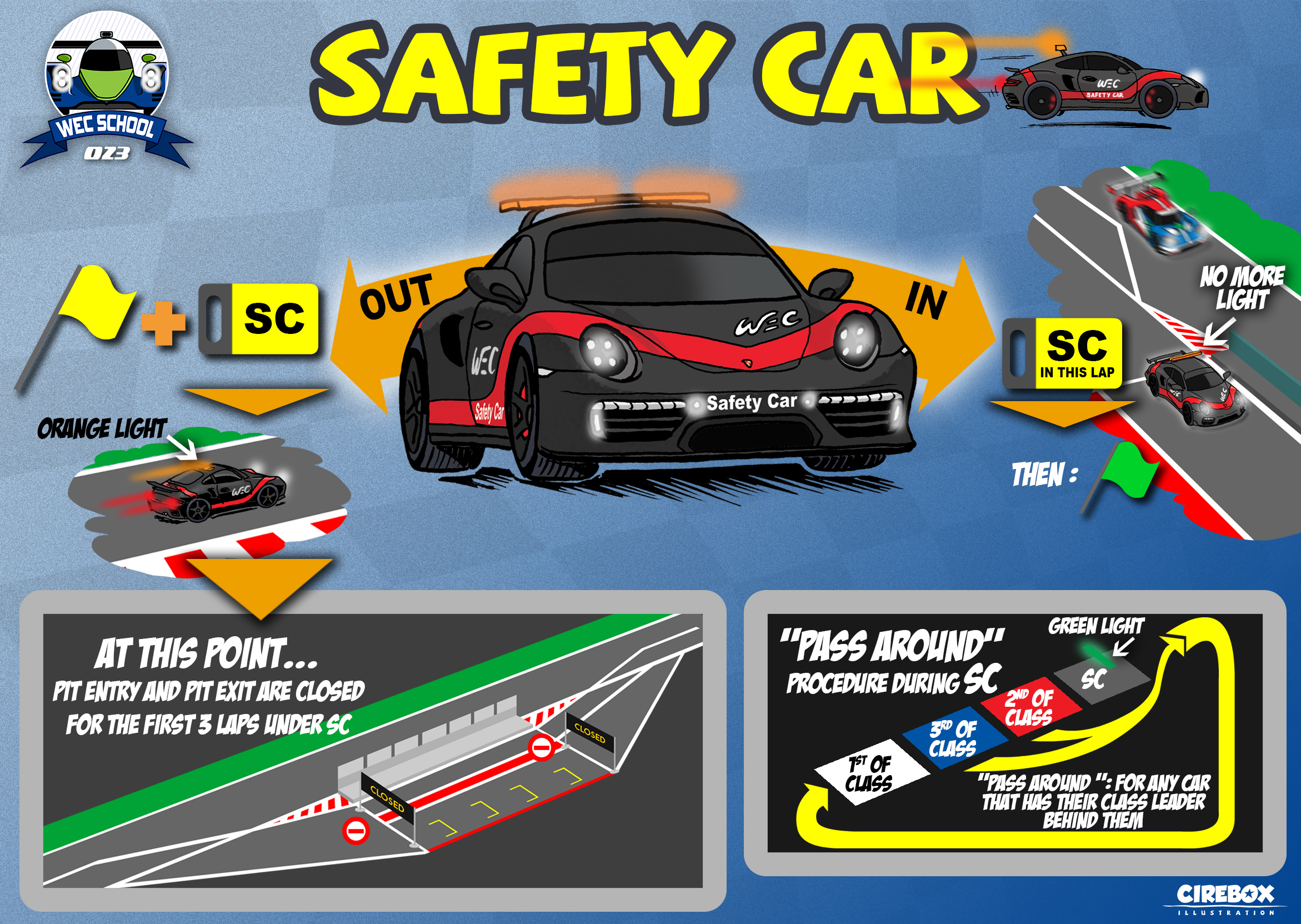2025 SPORTING REGULATIONS
The complete sporting regulations for the 2025 FIA World Endurance Championship can be consulted HERE .
DRIVER CATEGORIZATION & CREW COMPOSITION

Depending on their sporting record and their results, the drivers of the FIA World Endurance Championship (WEC) are categorized by a specific FIA committee as follows: Bronze, Silver, Gold, Platinum.
Hypercar: Bronze drivers are not authorized
LMGTE Pro: crew composition is free
LMP2: a crew of 2 or 3 drivers must include at least one Silver or Bronze driver
LMGTE Am: a crew of 2 or 3 drivers must include at least a Bronze pilot and a Bronze or Silver pilot
However, a special committee, composed of a representative of the FIA, a representative of the ACO and a representative of the organizer LMEM, may grant, at the request of a competitor, an exemption for the composition of the crews. . This must exemption not:
- Compromise safety on the track;
-Give a sporting advantage compared to other crews entered in the same category
In 2022, the specific classification in the LMP2 category for teams including Bronze drivers. The best LMP2 Pro/Am crew (thus including a Bronze driver) will be on the LMP2 podium:
1-FIA Endurance Trophy Ranking for LMP2 Pro/Am Teams
2-FIA Endurance Trophy Ranking for LMP2 Pro/Am Drivers
EQUIVALENCE SYSTEMS (PERFORMANCE AND TECHNOLOGY)
The equivalence system called "Balance of Performance" (BoP) applies to cars entered in the Hypercar, LMGTE Pro and LMGTE Am categories. The objective of the BoP is to allow cars of different technical designs to compete in the same category. The Endurance Committee will make adjustments to this BoP:
• As indicated in the Technical Regulations
• Via separate decisions taken by the Endurance Committee
Hypercar
To guarantee sporting fairness, the FIA and the ACO rely on the Balance of Performance formula jointly developed by the two parties. The BoP Hypercar has been tailor-made for the needs of this new category, based on the knowledge and experience acquired over the years.
The FIA and ACO have a long history of using BoP, beginning in GT racing in the mid-2000s, and are constantly improving the process. The best methods and lessons have been taken into account for the development of the BoP Hypercar.
One of the most innovative solutions is the use of torque measuring instruments, which allow better control of the power unit parameters on the track. These sensors, resistant to electromagnetic fields and heat, are used at the level of the transmission shaft of cars to measure and limit the power allocated by the BoP. Recently developed, this technology is effective in limiting development costs.
In 2021 and 2022, the old generation of non-hybrid LMP1 prototypes will be allowed to compete in the premier category alongside the Hypercars, and their performance will be balanced. In 2022, the regulation will authorize LMDh. Developed jointly by the ACO and IMSA, these cars share some elements with the next generation of LMP2 prototypes and will race in the WEC Hypercar category alongside the Hypercars.
LMP2
The FIA and the ACO do not wish to encourage LMP2 manufacturers to pursue performance developments. The main objectives of LMP2 prototypes must be reliability, safety and keeping costs low.
Car development is “frozen” until the end of 2022.
LMGTE PERFORMANCE SCALE
GTE cars are based on production models and are fundamentally different from each other. In order to have fairer competition, the legislator has the possibility of making adjustments to the performance of each car to allow each model to be competitive.
During the season, adjustments to the performance balance of cars entered in the LMGTE category are made automatically after a few rounds, according to evaluation criteria defined and approved ahead of said season by all parties concerned.
The calculation tool, and mathematical formulas based on specific data quantified and measured during each race, makes it possible to obtain this balance between the different car models, without any human interpretation or decision-making.
The following modifications can be applied:
• Minimum car weight
• Air intake flange and boost pressure ratio
• Fuel tank capacity
• Any other modifications that the WEC Committee deems necessary
LMGTE Am
Success Ballast will be imposed on LMGTE Am cars entered in the championship. It will be effective in all races, with the exception of the 24 Hours of Le Mans. The system for calculating this ballast uses the results of previous races (if they took place) and the championship positions, knowing that all cars start the season with a ballast of 0 kg.
QUALIFICATIONS AND POLE POSITION
TESTS
With the 2021 season being the first of a 5-year homologation cycle for the Hypercar category, there will be more pre- and in-race testing. The LMP2 and LMGTE Am categories will also benefit from additional testing. A declaration for these tests is always mandatory.
COST LIMITATION MEASURES
As part of the implementation of cost containment measures, the operational staff of Hypercar competitors will be limited to 40 (43 for cars with a hybrid system) and with the exception of the 24 Hours of Le Mans. Previously introduced changes intended to make engagement less costly include sea freight for overseas and intercontinental races. In order to take into account the current economic crisis, this season will take place over a reduced number of races to six compared to previous years.
TIRE ALLOCATIONS
Dry weather tires:

Wet weather tires:
Unless otherwise authorized in these regulations, wet track tires may only be used if the track has been declared wet by the Race Director / Clerk of the Course for the practice session (free practice, qualifying), and the race .
The number of rain tires usable during a competition is not limited
DRIVING TIME
Driving times have changed for 2023.
For a 6-hour race, the minimum driving time for a driver classified Silver or Bronze in LMP2 is 1h15 and in LMGTE Am, it is 1h45.
During an 8 hour race, the minimum driving time for Silver and Bronze drivers in LMP2 will be 1h40 and in LMGTE Am it will be 2h20.
If a driver does not reach his minimum driving time, a penalty will be imposed by the Stewards, up to and including disqualification.
If a driver exceeds his maximum driving time, a penalty will be imposed by the Stewards, up to and including disqualification.
SAFETY CAR

By decision of the Race Director, the safety car can neutralize the race if competitors or officials are in immediate physical danger (in circumstances which do not nevertheless justify stopping the race), give the start in exceptional circumstances (bad time for example), lead a rolling start, or even resume a suspended race.
The safety car is designed or adapted for high performance driving on the circuit. Thanks to its power, drivers on the track can follow it at reduced speed without compromising the normal operation of their car. The safety car will bear the words “SAFETY CAR” on the rear and sides in characters similar in size to the race numbers. It must be equipped with at least one yellow or orange light on the roof and one green light directed towards the rear, each powered by a different electrical circuit. It is driven by an experienced circuit driver accompanied by an observer, capable of recognizing all the cars in the race and in permanent radio contact with the Race Direction.
There will only be one safety car in service at a time, except on circuits longer than 7 km: other safety cars, parked at intermediate points around the circuit, may be authorized by the FIA.
When the order is given by the Race Direction to send the safety car onto the track, all marshal positions will display waving yellow flags, "SC" signs, while the orange lights on the line will be lit during the race. duration of the intervention. With orange lights also on, the safety car will start from the pit lane and enter the track, wherever the car leading the race is located. All competitors on track must line up behind the safety car at a distance of less than five car lengths. .
When the Race Director recalls the safety car, it turns off its orange lights and this is the signal for its return to the pit lane at the end of this lap. At this point, the first car in line behind the safety car can set the pace and, if necessary, be more than five car lengths behind it. Each lap covered under the safety car regime is counted as one lap of the race.
CLASSIFICATION CONDITIONS
Cars are ranked based on the number of complete laps covered during the duration of the race. The car having covered the greatest distance until the presentation of the checkered flag is classified first. To be classified, a competitor must have covered a distance at least equal to 70% of the distance covered by the car classified first in the general classification.


